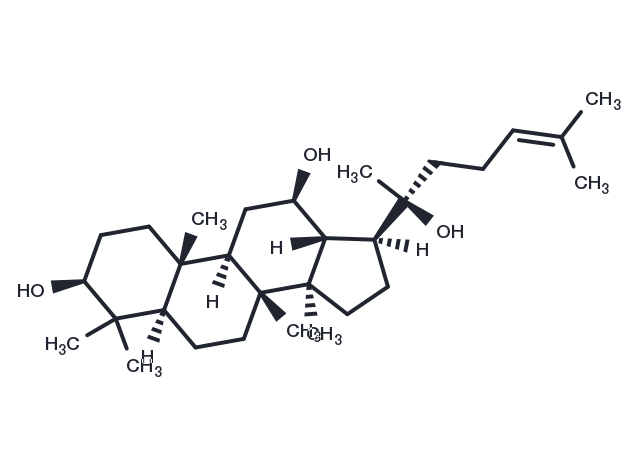Powder: -20°C for 3 years | In solvent: -80°C for 1 year
(20S)-Protopanaxadiol (20-Epiprotopanaxadiol) (20-Epiprotopanaxadiol), an apoptosis inducer, is an aglycon metabolic derivative of the protopanaxadiol-type ginseng saponin.

| パッケージサイズ | 在庫状況 | 単価(税別) | |||
|---|---|---|---|---|---|
| サンプルについてお問い合わせ | |||||
| 5 mg | 在庫あり | ¥ 10,500 | |||
| 10 mg | 在庫あり | ¥ 15,000 | |||
| 50 mg | 在庫あり | ¥ 56,000 | |||
| 100 mg | 在庫あり | ¥ 84,000 | |||
| 1 mL * 10 mM (in DMSO) | 在庫あり | ¥ 10,500 | |||
| 説明 | (20S)-Protopanaxadiol (20-Epiprotopanaxadiol) (20-Epiprotopanaxadiol), an apoptosis inducer, is an aglycon metabolic derivative of the protopanaxadiol-type ginseng saponin. |
| In vitro | Concentrations causing growth inhibition of 50% of cells (LC50) for the compounds PPD is 23 μg/ml, for Int-407 cells. The the LC50 for PPD is determined to be 24 μg/ml in Caco-2 cells. In the Int-407 cell line, PPD produces great percentage of sub-G1 (apoptotic) cells(The Int-407 cell line is a human embryonic nonmalignant cell line originating from fetal tissue of approximately 2 months gestation, whereas Caco-2 is a human colon adenocarcinoma cell line). This response is attributed to differences in individual ginsenoside glycosylation and, thus, the hydrophobic-hydrophilic balance [2]. Incubation with PPD also significantly reduces the viability of U251-MG and U87-MG cells in a dose- and time-dependent manner. The cytotoxic effect of PPD is accompanied by reduced expression of cell adhesion proteins, including N-cadherin and integrin β1, which leads to reduced phosphorylation of focal adhesion kinase. Furthermore, incubation with PPD reduces the expression of cyclin D1 and subsequently induces cell-cycle arrest at the G1 phase[3]. |
| In vivo | Treatment with PPD(20(S)-Protopanaxadiol) and PPT(20(S)-Protopanaxatriol) prior to immobilization stress increase the time spent in open arms and open arm entries in the elevated plus-maze (EPM) test. Treatment with PPD potently suppresses immobilization stress-induced serum levels of corticosterone and interleukin (IL)-6 by the enzyme-linked immunosorbent assay. PPD and PPT may exhibit the anxiolytic effect via γ-aminobutyrateA (GABAA) receptor(s) and serotonergic receptor(s), respectively, and PPD may have an anti-inflammatory effect that is more potent than that of PPT[1]. |
| 細胞研究 | Int-407 and Caco-2 cells are seeded at a concentration of 1×106 cells/mL in 24-well plates in separate experiments. Test ginsenosides (PPD, PPT, Rh2) are added to wells to the LC50 concentration determined previously from the MTT assays. The ginsenoside concentrations used for Int-407 cells are 23, 26, and 53 μg/mL, respectively, for PPD, PPT, and Rh2. In a similar experiment using Caco-2 cells, 24 μg/mL for both PPD and PPT and 55 μg/mL for Rh2 is used. Untreated cells represented the control. Cells are incubated at 37℃ in a 5% CO2 humidified incubator for 24, 48, and 72 h. Cell-free supernatant are obtained by centrifugation(400 g) for 10 min, and the lactate dehydrogenase (LDH) assay is conducted as previously reported.(Only for Reference) |
| 植物由来 |
| 別名 | 20-Epiprotopanaxadiol, 20(S)-APPD |
| 分子量 | 460.73 |
| 分子式 | C30H52O3 |
| CAS No. | 30636-90-9 |
Powder: -20°C for 3 years | In solvent: -80°C for 1 year
Ethanol: 31 mg/mL (67.3 mM)
DMSO: 85 mg/mL (184.6 mM)
H2O: < 1 mg/mL (insoluble or slightly soluble)
You can also refer to dose conversion for different animals. 詳細
bottom
Please see Inhibitor Handling Instructions for more frequently ask questions. Topics include: how to prepare stock solutions, how to store products, and cautions on cell-based assays & animal experiments, etc.
(20S)-Protopanaxadiol 30636-90-9 Apoptosis Immunology/Inflammation Membrane transporter/Ion channel Metabolism Neuroscience NF-Κb P-gp Reactive Oxygen Species ginseng Cluster of differentiation 243 20-Epiprotopanaxadiol (20S)Protopanaxadiol 20APPD 20(S)-APPD P-glycoprotein ABCB1 CD243 (20S) Protopanaxadiol Pgp MDR1 various tumor cells Protopanaxadiol Multidrug resistance protein 1 inhibit Inhibitor saponins Akt activity inhibitor
